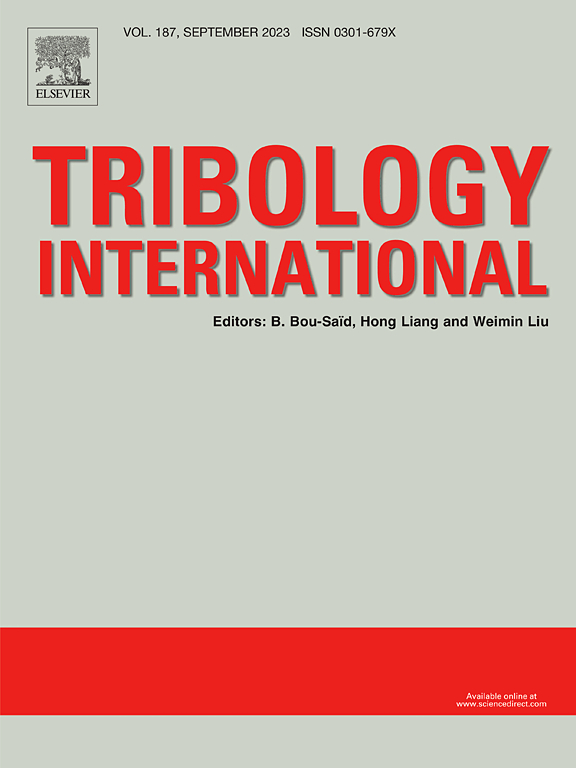Numerical investigation on pulling force and residual stresses in split-sleeve cold expansion of 2024-T3 aluminium alloy holes using a variable friction model
IF 6.1
1区 工程技术
Q1 ENGINEERING, MECHANICAL
引用次数: 0
Abstract
Three-dimensional elastic-plastic finite element (FE) simulations were conducted to examine the effect of friction models on the performance of the split-sleeve cold expansion process for 2024-T3 aluminium (Al) alloy. To accurately capture the tribological interaction of the MoS2-based solid lubricant between the mandrel and sleeve, we integrated an empirically derived, contact-pressure-dependent variable friction model into the FE framework. A constant friction coefficient of 0.05 was applied for comparison. For each friction model, response surface analysis was performed using FE simulation results to systematically assess the effects of the cold expansion percentage and workpiece thickness on mandrel pulling force and residual stress fields around the cold-expanded holes. Split-sleeve cold expansion experiments, resulting in aluminium holes with a final diameter of 5.896 mm, were conducted for validation. Our comparative analysis shows that the variable friction model predicts mandrel pulling peak forces with errors within 10 % of the experimental values, whereas the constant friction model yields errors ranging from 11 % to 42 %. The variable friction model effectively captures the tribological behavior of the solid lubricant by accounting for the reduction in friction coefficient at the mandrel-sleeve interface as the mandrel passes through the aluminium hole under increasing contact pressure. The hole diameter estimates obtained using the variable friction model closely match experimental measurements, whereas the constant friction model overestimates hole diameters.
基于变摩擦模型的2024-T3铝合金孔裂套冷胀拉拔力和残余应力数值研究
采用三维弹塑性有限元模拟方法研究了摩擦模型对2024-T3铝合金裂套冷胀过程性能的影响。为了准确捕捉基于mos2的固体润滑剂在芯棒和套筒之间的摩擦学相互作用,我们将经验推导的、依赖于接触压力的变量摩擦模型集成到有限元框架中。采用恒摩擦系数0.05进行比较。针对每种摩擦模型,利用有限元模拟结果进行响应面分析,系统评估冷胀率和工件厚度对冷扩孔周围芯轴拉力和残余应力场的影响。通过裂套冷膨胀实验,得到了最终直径为5.896 mm的铝孔。我们的对比分析表明,可变摩擦模型预测心轴拉力峰值的误差在实验值的10 %以内,而恒定摩擦模型的误差在11 %到42 %之间。可变摩擦模型考虑了心轴在接触压力增加的情况下穿过铝孔时,心轴-套界面处摩擦系数的减小,从而有效地捕捉了固体润滑剂的摩擦学行为。采用变摩擦模型得到的井径估计值与实验测量值吻合较好,而恒摩擦模型对井径估计过高。
本文章由计算机程序翻译,如有差异,请以英文原文为准。
求助全文
约1分钟内获得全文
求助全文
来源期刊

Tribology International
工程技术-工程:机械
CiteScore
10.10
自引率
16.10%
发文量
627
审稿时长
35 days
期刊介绍:
Tribology is the science of rubbing surfaces and contributes to every facet of our everyday life, from live cell friction to engine lubrication and seismology. As such tribology is truly multidisciplinary and this extraordinary breadth of scientific interest is reflected in the scope of Tribology International.
Tribology International seeks to publish original research papers of the highest scientific quality to provide an archival resource for scientists from all backgrounds. Written contributions are invited reporting experimental and modelling studies both in established areas of tribology and emerging fields. Scientific topics include the physics or chemistry of tribo-surfaces, bio-tribology, surface engineering and materials, contact mechanics, nano-tribology, lubricants and hydrodynamic lubrication.
 求助内容:
求助内容: 应助结果提醒方式:
应助结果提醒方式:


